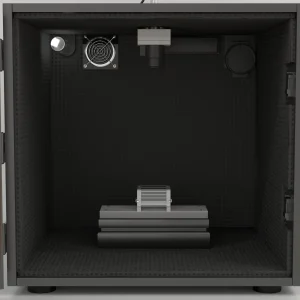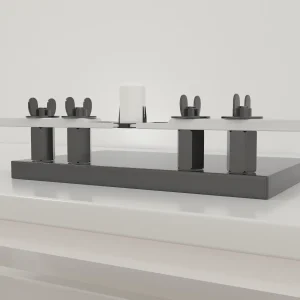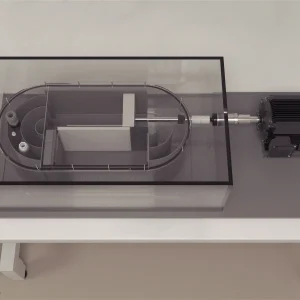$790.00 – $890.00
The Emergence Test is a specialized experimental method designed to evaluate neophobia and exploratory behavior in rodents. It builds upon the Open-field test, a well-established assay used to study anxiety and exploratory tendencies. Rodents have a natural inclination to explore but also display a strong aversion to brightly lit, open spaces. The Emergence Test leverages these traits to assess how rodents respond to new environments.
The Rodent Emergency Test is another behavioral assessment used to examine rodents’ ability to navigate complex environments. This test provides insights into cognitive and motor skills and can reveal any effects resulting from exposure to substances or other experimental conditions. It typically involves guiding the rodent through a maze with the promise of a food or water reward upon completion. This test is valuable in fields such as neuroscience, toxicology, and behavioral biology for studying learning, memory, and the impact of various substances on behavior.
Maze Engineers provides the Emergency Test Maze for conducting these assessments.

MazeEngineers offers custom-built behavioral mazes at no extra cost—designed to fit your exact research needs. Eliminate reproducibility issues from poor sizing or lingering scent cues with precision-engineered, modular, and smart mazes that adapt in real time to animal behavior. Publish new protocols, run adaptive experiments, and push the boundaries of behavioral science.



Mouse |
40×40 cm; 30cm height |
Cylinder: 13.2 x 4.4 x 4.4 cm |
Rat |
60×60 cm; 40cm height |
Cylinder: 21 X 7 X 7 cm |

The Emergence Test is designed to minimize handling of the subject. It involves placing the animal in a holding container before introducing it into an open arena. The holding container offers a secure environment compared to the more exposed open-field arena. The primary task is to measure how long it takes for the subject to leave the container and begin exploring the arena. Animals with elevated anxiety levels typically remain in the container longer, avoiding the open space. This test is useful for assessing the impact of anxiogenic and anxiolytic substances on behavior, as well as for investigating lesion-induced behaviors and neuropsychiatric conditions.
The apparatus for the Emergence Test includes a spacious open field with high walls and a cylindrical holding container, all made from opaque acrylic. Other commonly used tests for evaluating locomotion and anxiety-related behaviors include the Elevated Plus Maze, the Zero Maze, and the Light/Dark Box.
The Emergence Test apparatus is made from opaque acrylic and features an enclosed open field. The high walls of the field keep the subject contained and eliminate external visual cues that could affect the subject’s behavior. The holding container is an opaque cylinder, measuring 21 x 7 x 7 cm, which houses the subject. The cylinder is fitted with lids and is firmly fixed to the apparatus to prevent any movement or rolling.
Before starting the trials, thoroughly clean the apparatus using a 70% ethanol solution. It is important to clean the equipment between trials to avoid any residual stimuli affecting performance. Ensure the maze is well-lit with overhead lighting to eliminate shadows. For detailed observations, a video and tracking system like Noldus EthoVision XT can be utilized.
As the Emergence Test is designed to assess neophobia, pretraining of the subject is not necessary.
The data obtained from the Emergence Test is straightforward. The parameters that can be recorded are as follows,
Leibrock, C., Ackermann, TF., Hierlmeier, M, Lang, F., Borgwardt, S., Lang, UE. (2013). Akt2 Deficiency is Associated with Anxiety and Depressive Behavior in Mice. Cell Physiol Biochem, 32(3), 766-777.
Holson, R. R. (1986). Mesial Prefrontal Cortical Lesions and Timidity in Rats. Physiology & Behavior, 37, 221-230.
Lalonde, R., & Strazielle, C. (2009). The relation between open-field and emergence tests in a hyperactive mouse model. Neuropharmacology, 57, 722-724.
Pare, W. P., Tejani-Butt, S., & Kluczynski, J. (2001). The Emergence Test: Effects of Psychotropic Drugs on Neophobic Disposition in Wistar Kyoto (WKY) and Sprague Dawley Rats. Prog Neuro-psychopharmacol and Biol.Psychiat., 25, 1615-1628.
| Species | Mouse, Rat |
|---|
There are no questions yet. Be the first to ask a question about this product.
Monday – Friday
9 AM – 5 PM EST
DISCLAIMER: ConductScience and affiliate products are NOT designed for human consumption, testing, or clinical utilization. They are designed for pre-clinical utilization only. Customers purchasing apparatus for the purposes of scientific research or veterinary care affirm adherence to applicable regulatory bodies for the country in which their research or care is conducted.